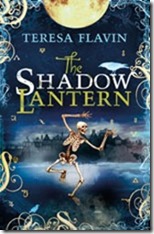To celebrate the launch of Teresa Flavin’s finaly book in the Blackhope Enigma trilogy, I am pleased to welcome her back on the blog to tell us what it is really like to write a trilogy.
Authors sometimes describe themselves as architects or gardeners when it comes to writing their stories, though I’ve heard some variations on those names including plotters and pantsers. Architects and plotters build their books based on a plan while gardeners sow seeds of ideas and let them grow organically – and pantsers apparently fly by the seats of their pants with little idea of where their stories will go when they begin. I’ve always considered myself an architect/plotter because I make mind maps and flow charts to work out my stories. I create more diagrams to guide me when I revise manuscripts; the big paper sheets always end up covered in circled text, block printing and exclamation points done in several ink colours like this example from The Crimson Shard.
But when my first fantasy-adventure novel, The Blackhope Enigma, unexpectedly spawned a sequel, I began to feel more like a gardener. I hadn’t set out to continue the story but there were some tantalising buds of ideas that I wanted to explore further. Those buds bloomed into The Crimson Shard. This story took place in a completely new world based upon eighteenth-century London, but it had clear roots in The Blackhope Enigma. It wasn’t difficult to link back to the first book but I had to be careful not to lumber readers with too much back story and interrupt the narrative flow. At the same time, I had to assume that readers might not have read Blackhope and include enough background for aspects of the sequel to make sense. The trick was to make the story work as a stand-alone and as part of a series at the same time. Getting that balance right can be tough, so my editors’ feedback on the drafts was crucial.
This proved to be even more important when I embarked on writing The Shadow Lantern, which I had decided would be the final in the series. The roots that had grown out of The Blackhope Enigma and into The Crimson Shard now needed to be woven into a further adventure. And this time I was putting my main characters back in the setting where the first book had started, a Scottish castle with deep secrets. On top of that, I was pulling in a few supporting characters that had appeared in the previous two books, but not necessarily together.
I had to clarify who these characters were with just the right amount of explanation. I also needed to refer to key things that had happened in each book so that this new story would make sense. Did I know how much description was enough? No. I decided that the best thing to do – for me – was to include back story wherever I thought it was needed, even if it was way too much. This resulted in much repetition and some very clunky sections that broke the story’s momentum. I removed the most repetitive and wooden bits after a read-through, but I was not sure how far to go. I knew that I was still hitting my potential readers over the head with clarifications, but I was so close to the story, I needed to step back and get some perspective. My top way to do this is to read my work aloud. When I stumbled over those clunky passages and cringed, I knew where to revise. But this only went so far.
Nothing beats a fresh pair of eyes – or better yet, multiple pairs. My editors at Templar Publishing are expert at predicting when a young reader is going to be baffled or bored. They have the advantage of having read my previous books, but not recently, so they come to my new manuscripts with clarity. With each suggestion they made on The Shadow Lantern, I not only got insight into how to make the problem areas work but I learned more skills for my writing toolkit.
After all the challenges of writing complex, interlinked stories, it’s been a joy to bring the final book to life. An architect might say she has built three houses with passages between them; a gardener might say she has grown three trees with intertwined roots. I prefer to think of three tree houses joined by planks, branches and ropes – worlds of fun and intrigue that I am so pleased to have created.
The Shadow Lantern by Teresa Flavin is published by Templar Fiction today. It is the third and final book in The Blackhope Enigma series.
To find out more about Teresa Flavin:



No comments:
Post a Comment
Hiya, thanks for stopping by, it is always nice to hear what you have to say, so do leave a comment if you have time.